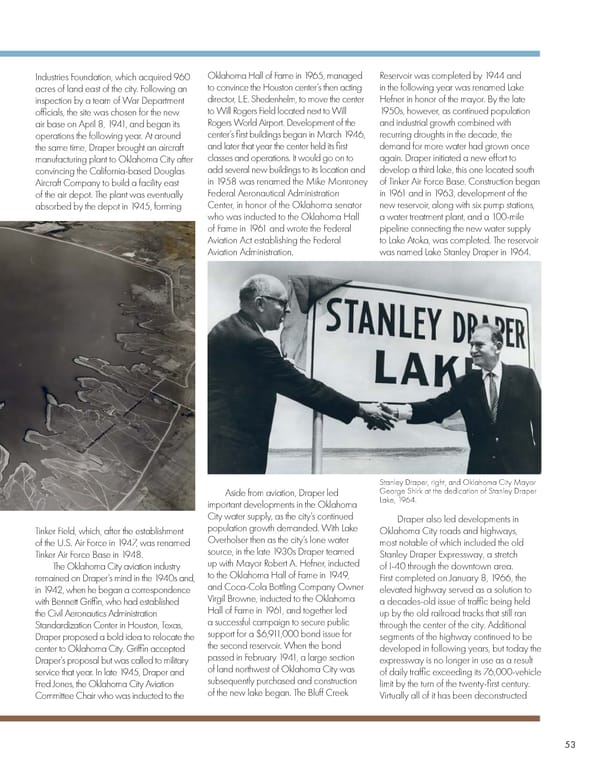Industries Foundation, which acquired 960 Oklahoma Hall of Fame in 1965, managed Reservoir was completed by 1944 and acres of land east of the city. Following an to convince the Houston center’s then acting in the following year was renamed Lake inspection by a team of War Department director, L.E. Shedenhelm, to move the center Hefner in honor of the mayor. By the late officials, the site was chosen for the new to Will Rogers Field located next to Will 1950s, however, as continued population air base on April 8, 1941, and began its Rogers World Airport. Development of the and industrial growth combined with operations the following year. At around center’s first buildings began in March 1946, recurring droughts in the decade, the the same time, Draper brought an aircraft and later that year the center held its first demand for more water had grown once manufacturing plant to Oklahoma City after classes and operations. It would go on to again. Draper initiated a new effort to convincing the California-based Douglas add several new buildings to its location and develop a third lake, this one located south Aircraft Company to build a facility east in 1958 was renamed the Mike Monroney of Tinker Air Force Base. Construction began of the air depot. The plant was eventually Federal Aeronautical Administration in 1961 and in 1963, development of the absorbed by the depot in 1945, forming Center, in honor of the Oklahoma senator new reservoir, along with six pump stations, who was inducted to the Oklahoma Hall a water treatment plant, and a 100-mile of Fame in 1961 and wrote the Federal pipeline connecting the new water supply Aviation Act establishing the Federal to Lake Atoka, was completed. The reservoir Aviation Administration. was named Lake Stanley Draper in 1964. Stanley Draper, right, and Oklahoma City Mayor Aside from aviation, Draper led George Shirk at the dedication of Stanley Draper important developments in the Oklahoma Lake, 1964. City water supply, as the city’s continued Draper also led developments in Tinker Field, which, after the establishment population growth demanded. With Lake Oklahoma City roads and highways, of the U.S. Air Force in 1947, was renamed Overholser then as the city’s lone water most notable of which included the old Tinker Air Force Base in 1948. source, in the late 1930s Draper teamed Stanley Draper Expressway, a stretch The Oklahoma City aviation industry up with Mayor Robert A. Hefner, inducted of I-40 through the downtown area. remained on Draper’s mind in the 1940s and, to the Oklahoma Hall of Fame in 1949, First completed on January 8, 1966, the in 1942, when he began a correspondence and Coca-Cola Bottling Company Owner elevated highway served as a solution to with Bennett Griffin, who had established Virgil Browne, inducted to the Oklahoma a decades-old issue of traffic being held the Civil Aeronautics Administration Hall of Fame in 1961, and together led up by the old railroad tracks that still ran Standardization Center in Houston, Texas, a successful campaign to secure public through the center of the city. Additional Draper proposed a bold idea to relocate the support for a $6,911,000 bond issue for segments of the highway continued to be center to Oklahoma City. Griffin accepted the second reservoir. When the bond developed in following years, but today the Draper’s proposal but was called to military passed in February 1941, a large section expressway is no longer in use as a result service that year. In late 1945, Draper and of land northwest of Oklahoma City was of daily traffic exceeding its 76,000-vehicle Fred Jones, the Oklahoma City Aviation subsequently purchased and construction limit by the turn of the twenty-first century. Committee Chair who was inducted to the of the new lake began. The Bluff Creek Virtually all of it has been deconstructed 53 35
 June 2021 Oklahoma Hall of Fame Magazine Page 54 Page 56
June 2021 Oklahoma Hall of Fame Magazine Page 54 Page 56